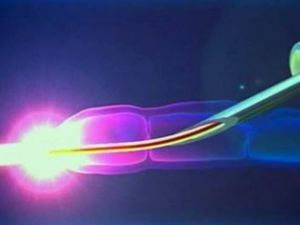 Varicose veins are a fairly serious disease that causes swelling, pain in the legs, trophic ulcers and acute thrombosis.
Varicose veins are a fairly serious disease that causes swelling, pain in the legs, trophic ulcers and acute thrombosis.
With the development of this disease in patients very often there are convulsions in the calf muscles, heaviness in the legs, veins widen.
In the evening, the patient very often notices swelling of the legs, which disappears in the morning.
Contents
- Features of laser phlebectomy
- How does the laser work?
- Advantages of using
- procedure Contraindications to
- procedure Preparation for
- operation
- procedure features Recovery phase
- Possibility of complications
Features of laser phlebectomy
To date, there are a large number of methods for treating varicose veins. Recently, the most commonly used for this purpose is laser phlebectomy.
This method of treatment does not require hospitalization of the patient. It belongs to the category of sparing methods, with the help of which the highest quality treatment of large veins is carried out.
Laser treatment of varicose veins was first launched in the 90's. For the treatment, it is necessary to use special expensive equipment. 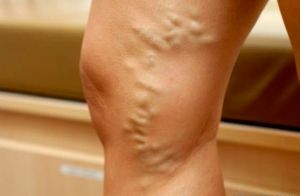
Phlebectomy belongs to the category of modern high-tech treatments for vein dilatation. When using this method of treatment, surgical intervention is not necessary to remove veins.
In order to increase the cosmetological effect of phlebectomy, it is often combined with sclerotherapy.
Despite the fact that laser phlebectomy is a new intervention, it is highly effective in treating varicose veins.
How does the laser work?
During the use of this technique, the laser beam acts directly on the inner wall of the vein. This modern laser system uses the Power Matrix technology.
It is characterized by a high level of security, which allows it to be used for any patient. During the application of the technology, separate matrices are used, which include high-efficiency diodes.
During the procedure, the diodes are collected in a single unit, which has built-in cooling.
Next, the micro-optics generated by the laser are focused and directed to the laser fiber region.
For safety, a special system is used, as well as the means by which the fiber is protected.
If overheating occurs during the procedure, the power supply to the fiber tip is terminated by the fiber protection system. This limits the possibility of destroying the tip and reduces the risk of tissue damage.

Advantages of using the
technique The technique of removing veins is characterized by a huge number of advantages. This procedure can be performed under local anesthesia. This excludes the possibility of complications, which are very often found in surgical interventions.
There is no partial loss of skin sensitivity near the remote vein.
Also to advantages of a method it is possible to carry:
- the minimal quantity of a dyscomfort;
- durability effect;
- is the fastest recovery process;
- no scars.
The undeniable advantage of this method is that the procedure can be simultaneously carried out on two legs. Regardless of the degree of neglect of varicose veins, the operation lasts about 40 minutes on average.
During the procedure, the nearest lymph nodes are not injured and do not swell.
Contraindications to the procedure
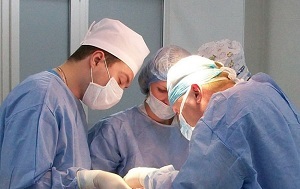 Treatment of varicose veins with a laser is characterized by low traumatism. That is why it is used to treat varicose veins in many patients.
Treatment of varicose veins with a laser is characterized by low traumatism. That is why it is used to treat varicose veins in many patients.
Despite the high level of safety of this method of treatment, it is prohibited in a number of cases. If the patient is diagnosed with varicose veins at a neglected stage, then the procedure is strictly forbidden to him.
In ischemic heart disease, this method of treatment should also not be used. Doctors are forbidden to intervene in patients with hypertension.
If severe infectious processes occur in the patient's body, this method of treatment is not used.
Phlebectomy is not performed in elderly patients. At late pregnancy, this method is strictly prohibited.
Doctors do not recommend the use of interventions for those patients who have diabetes mellitus. Also, the procedure is not carried out with a heart attack or stroke.
In erysipelas or eczema, it is also strictly forbidden to apply this method of treatment.
Preparation for surgical intervention
After the patient has consulted the doctor, a complete examination is performed. Then the patient is sent for ultrasound examination of the veins of the lower extremities.
This will allow the doctor to assess the degree of the disease and its nature. Before the procedure, the doctor marks the varicose veins. Also, the definition of perforating vessels, which have lost their efficiency.
Before the intervention, the patient must necessarily pass blood and urine tests.
In order to find out whether a patient can fully transfer the procedure, he is assigned an electrocardiogram. In the presence of allergic reactions to certain medications taken by the patient before, he needs to tell the doctor about it.
Features of procedure
A phlebectomy can be performed by one specialist or several doctors. For this purpose, special tools are used - probes. 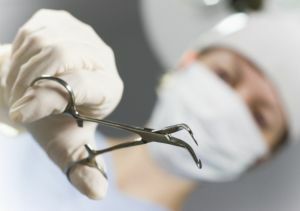
A blood vessel, which is affected by varicose veins, the doctor ties up at the place where it connects to the deep vein.
Next, the doctor removes the enlarged site of the vein. To this end, the specialist makes small incisions and introduces through them a probe, through which the veins are pulled out. Then the vein is removed.
After the surgical intervention is completed on the incisions, a special cosmetic sutures are applied. After a short period of time, the seams will be very difficult even under a microscope.
If necessary, the seams may not overlap. Their connection is carried out by gluing. For this purpose, special strips are used.
If a patient underwent a mini-flexibectomy, surgical intervention was performed through punctures. In this case, the puncture sites are able to heal themselves.
Restorative stage
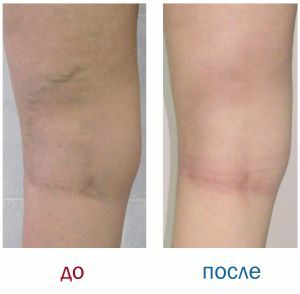 In the postoperative period, the patient is prescribed medication and therapeutic gymnastics. The choice of specific therapy is carried out depending on the nature of the procedure and the patient's condition.
In the postoperative period, the patient is prescribed medication and therapeutic gymnastics. The choice of specific therapy is carried out depending on the nature of the procedure and the patient's condition.
Immediately after the intervention, an elastic bandage is wound on the leg. The foot of the patient should lie on the platen.
On the second day after the surgical procedure, the patient should start walking. This process should last no more than 10 minutes. After removing the joints, the patient is prescribed a massage.
Possible complications of
Degree of neglect of the disease, age of the patient, concomitant diseases directly affect the level of success of the operation.
These factors can adversely affect the patient's body, leading to complications. Most often, after the intervention, the patient is bruised. But this phenomenon is quite normal. He is not classified as a complication.
If the patient is numb in the lower extremities and the sensitivity of the skin is reduced, this often leads to damage to the nerve endings.
In places where hematomas have formed after the intervention, suppuration may occur. In some patients, as a result of the procedure, new veins in the scar formation may be observed. After the procedure in this area, the patient may experience pain.
More details on how the treatment of varicose veins with a laser, as well as study patient feedback can be found on the link.
Laser phlebectomy is a highly effective method of treating varicose veins, which does not require serious surgical intervention.
